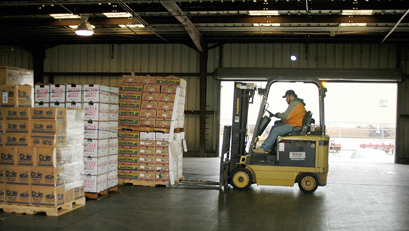
Ag Against Hunger connects farms and local pantries
Living in California
– with its abundance of fresh fruits and vegetables – one might
take for granted the proximity to locally grown produce. Though one
segment of the population doesn’t have the luxury of browsing local
farmers’ markets or grocery stores for the best of crops, a local
non-profit organization is hel
ping to connect the needy with healthy foods.
Ag Against Hunger connects farms and local pantries
Living in California – with its abundance of fresh fruits and vegetables – one might take for granted the proximity to locally grown produce. Though one segment of the population doesn’t have the luxury of browsing local farmers’ markets or grocery stores for the best of crops, a local non-profit organization is helping to connect the needy with healthy foods.
San Benito, Monterey and Santa Cruz county growers and shippers banded together in 1990 to form Ag Against Hunger. The program connects agricultural companies with excess produce to local pantries – a nutritional need that has historically been hard to fill for homeless or extremely low-income populations.
“There is so much produced here,” said Joe Pezzini, of Ocean Mist Farms in Castroville. “The season is usually pretty long – from March to November.”
Ag Against Hunger collects up to 12 million pounds of produce each year. Products contributed by local companies run the gamut of crops that are grown in the region – lettuces, celery, broccoli, strawberries, mushrooms, snap peas, beans and carrots.
“There is usually some product left that is good,” said Pezzini, who also serves as board president for AAH. “Maybe the market changes so not as much is needed.”
AAH accepts any of the produce offered to it and gives first dibs to local pantries in the tri-county area, including Community Pantry in San Benito.
“We are providing fresh fruits and vegetables to people with the fewest resources and the highest risk for obesity,” said Abby Taylor, the executive director of AAH. “The service we provide is really bringing nutritious foods into the homes of people who need it most.”
Local pantries accept a quarter of the produce each year and AAH works with other pantries throughout California and the Western states to distribute the rest.
“It is grown here and we want to make sure the people who live in the counties receive it first,” Taylor said. “Then we send it to other parts of the state or country.”
As much as 70 percent of the produce stays within California and Taylor said more of it doesn’t stay in the tri-county area because of storage constraints at many of the local pantries.
“One of the good things is that we can take as much as the grower has to give,” Taylor said. “But pantry facilities can’t hold that much so they can’t take as much as they want.”
Community Pantry currently has a warehouse that is about 3,000 square feet and only a portion of that is available for refrigeration. The local pantry has plans for a new warehouse that could be up to 10,000 square feet and would include more storage space for items that require refrigeration, according to Mary Anne Hughes, the pantry’s executive director.
“It isn’t sitting in our cooler for very long,” Taylor said. “Whether we have four pallets or 24 pallets, we offer it to all our locals, but will definitely get it to other food bank if they don’t take it.”
One way that excess produce is collected – and the way Pezzini first got involved with AAH – is through gleaning.
“My first involvement was sourcing fields for their gleaning program,” Pezzini said. “I used to meet them in the [Orchard Supply Hardware] parking lot and take them out to fields of broccoli or cauliflower.”
In the program, volunteers go out to local fields and collect the high quality produce that is left behind after commercial harvest. The produce collected is then distributed to pantries. AAH also works with local growers and shippers when produce doesn’t leave their warehouse soon enough to be sold on the market or when they have more produce than the market requires.
“There is usually some product left that is good,” said Joe Pezzini, of Ocean Mist Farms in Castroville. “Maybe the market changes so not as much is needed.”
Market demands fluctuate often, some times weekly or daily, Pezzini explained. Once companies have packaged or boxed up produce, they usually have a short turn around to get it out of their warehouses.
“With salad plants, they need to ship it really quickly,” Pezzini said. “The product is still good. It just doesn’t have a home. If there is product we don’t move in time, [AAH] can come pick it up.”
Like Pezzini, the board is made up of representatives from local agricultural companies such as Earthbound Farms and Driscoll Strawberries.
“These are companies that support the program with produce and financially to keep it going,” Pezzini said.
The organization received extra funding from the Harden Foundation this year with a $20,000 grant that allowed them to continue to collect local produce during the winter months.
For more information on Ag Against Hunger or to volunteer with the gleaning program, please call 831-755-1480.
SEE RELATED STORY:
SEE RELATED STORY:








